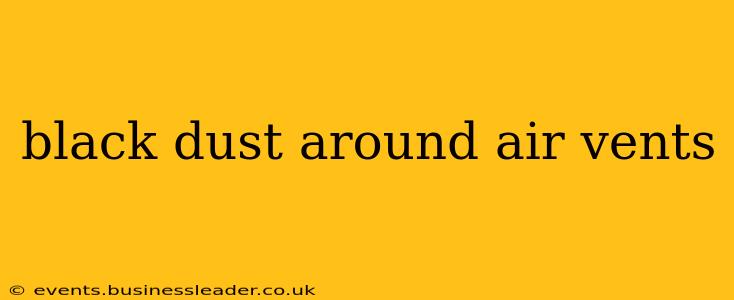Finding black dust around your air vents is unsettling. It suggests something's amiss in your home's ventilation system, potentially impacting indoor air quality and even posing health risks. This comprehensive guide explores the common culprits behind this issue, effective solutions, and proactive prevention strategies to ensure cleaner, healthier air in your home.
What Causes Black Dust Around Air Vents?
Several factors contribute to the accumulation of black dust around air vents. Identifying the root cause is crucial for effective remediation. The most common culprits include:
-
Mold and Mildew: Damp conditions within your ductwork provide the perfect breeding ground for mold and mildew. These microorganisms can produce dark spores that appear as black dust. This is especially concerning for those with respiratory sensitivities.
-
Dust and Debris: Over time, dust, dirt, pet dander, and other airborne particles accumulate in your ductwork. Airflow through the vents then distributes this dust throughout your home, often concentrating around the vent openings.
-
Rodents and Insects: Rodent droppings and insect carcasses (especially cockroaches) can leave behind dark residues that resemble black dust. This not only looks unsightly but also introduces potential allergens and pathogens.
-
Combustion byproducts: If you have a wood-burning fireplace or stove, or if you have issues with your furnace, soot can be circulated through your air ducts, resulting in black dust around the vents.
-
Construction Dust: If your home is relatively new or has recently undergone renovations, lingering construction dust might be circulating through your HVAC system.
-
Improper Ventilation: Poor ventilation can trap pollutants and dust, leading to accumulation around vents.
How to Clean Black Dust from Air Vents?
Cleaning the visible black dust is only a temporary solution; addressing the underlying cause is essential. However, here are some cleaning steps to take:
-
Gather your supplies: You'll need a vacuum cleaner with a brush attachment, microfiber cloths, and possibly a disinfectant cleaner (for mold and mildew). Consider wearing a face mask to protect yourself from inhaling dust particles.
-
Vacuum the vents: Gently vacuum the vents, paying close attention to crevices and corners. The brush attachment will help remove dust effectively.
-
Wipe down the vents: After vacuuming, use a damp microfiber cloth to wipe down the vent covers and surrounding areas. If you suspect mold, use a disinfectant appropriate for mold and mildew removal. Always follow the product instructions carefully.
-
Deep Cleaning: While cleaning the visible dust is crucial, the dust in your air ducts requires professional attention, as this would involve disassembling and thoroughly cleaning the ducts. This is often the best step to prevent recurring problems.
Should I Call a Professional?
While you can tackle surface cleaning, a professional HVAC technician is recommended if:
-
The black dust is extensive: A significant accumulation suggests a more serious underlying issue.
-
You suspect mold or mildew: Professional mold remediation ensures complete removal and prevents health problems.
-
You're uncomfortable cleaning the vents yourself: Hiring a professional eliminates the hassle and potential risks.
-
You have recurring problems: If the black dust keeps reappearing after cleaning, professional inspection and duct cleaning are necessary.
How Can I Prevent Black Dust Around Air Vents?
Prevention is key to maintaining clean air. Here's what you can do:
-
Regular HVAC maintenance: Schedule annual HVAC inspections and cleaning to remove dust and debris from your ductwork.
-
Change air filters regularly: This prevents dust from circulating throughout your system. Follow the manufacturer's recommendations for filter replacement.
-
Address moisture issues: Fix any leaks or damp areas in your home to prevent mold and mildew growth. Ensure proper ventilation in bathrooms and kitchens.
-
Regular home cleaning: Regular dusting and vacuuming will reduce the amount of dust that accumulates in your ductwork.
-
Pest control: Regular pest control services can prevent rodent and insect infestations.
What is the best way to clean air ducts?
The best way to clean air ducts is to hire a professional duct cleaning service. They have specialized equipment and experience to effectively and safely remove dust, debris, and other contaminants from your entire ductwork system. Attempting to clean your ductwork yourself can be challenging and may not be as effective.
Is black dust in air vents dangerous?
Black dust in air vents can be dangerous depending on the source. Mold and mildew can cause respiratory problems. Rodent droppings contain harmful bacteria and allergens. Soot from combustion can contain harmful chemicals. If you have concerns about your health, consult a physician.
By understanding the causes of black dust around air vents and taking proactive steps to prevent it, you can ensure a healthier and more comfortable living environment. Remember, professional assistance is often necessary for thorough cleaning and resolving underlying issues.
